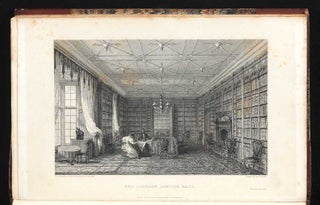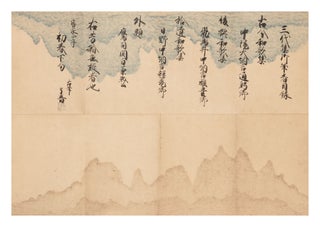Probably the First Practical Manual of Meditation in China
J: Shuju shikan zazen hoyo 修習止觀坐禪法要; alternate titles: Domo shikan & Shoshikan [Ch.: Xiu xi zhi guan zuo chan fa yao; alternate title: Hsiao-chih-kuan; The Method for Practicing Cessation & Contemplation by Sitting in Meditation].
Ten columns, 20 characters per column. 43 folding leaves. Ten chapters in one vol. Large 8vo, orig. brown wrappers (rather rubbed), new stitching. [Japan]: from the colophon, in trans.: “February 1629.”
First edition to be printed in Japan of the summary and update of what is probably the first practical manual of meditation in China (Sekiguchi, in trans.); it served as the model for almost all subsequent meditation manuals (Swanson, p. 2). It was “by far the most comprehensive systematization of Buddhist practise to date.”–Neal Arvid Donner, The Great Calming and Contemplation of Chih-I. Chapter One: The Synopsis. Translated, Annotated, and with an Introduction (Ph.D. thesis, University of British Columbia, April 1976), p. 6.
This is a very rare wooden movable type book; we find no copy in WorldCat, Kawase, or NIJL. While there is no direct evidence of place of printing, we believe this is a rare example of an Eizan-ban, “editions published at the Enryakuji monastery complex on Mount Hiei outside Kyoto. There were few of these in the medieval period…Eizan printing came into its own on a large scale only from the end of the sixteenth century, with the introduction of movable-type printing. Typographic printing flourished at various temples on Hieizan from the Keicho to Kan’ei periods (1596-1644), and with the publication of Chinese works as well as Tendai scriptures, publication and distribution at Hieizan began to develop into the beginnings of a commercial enterprise.”–K.B. Gardner, “Centres of Printing in Medieval Japan: late Heian to early Edo period” in British Library Occasional Papers 11. Japanese Studies (ed. by Yu-Ying Brown), London: 1990, p. 164.
Zhiyi (538-97), one of the most influential monks in Chinese Buddhist history, was the founder of the Tiantai (Japanese: Tendai) tradition of Buddhism in China. “Tiantai was the earliest of the three great traditions to emerge in the sixth and seventh centuries (Faxiang and Huayan being the other two), and it wrought a fundamental change in Chinese Buddhism, marking a shift away from the kind of translation and exegesis that had been driven mainly by a desire to understand correctly the writings of the Indian masters towards a Buddhism more in tune with Chinese attitudes, thought and habit.”–Richard Bowring, The Religious Traditions of Japan, 500-1600, p. 119.
The present work is Zhiyi’s “concise and influential meditation manual…This short text is a summary and update of the Tz’u-ti ch’an-men [The Gradual Practice of Ch’an/Dhyana] (not, as commonly misunderstood, of the Mo-ho chih-kuan). It was probably compiled while Chih-i [Zhiyi] was sequestered on Mt. T’ien-t’ai (from the age of 38 to 48) — a time when he had a ‘great awakening’ into the threefold truth…
“This text is an introductory manual for ‘sitting in Zen meditation’…The text opens with a lucid exposition of the ideal balance of chih (ch’an meditation and the concentrated and quiescent state attained thereby) and kuan (contemplation and the wisdom attained thereby).”–Paul L. Swanson, “Ch’an and Chih-kuan. T’ien-t’ai Chih-i’s View of ‘Zen’ and the Practice of the Lotus Sutra,” pp. 3-4.
A very good copy, preserved in a chitsu. There is some mostly marginal worming and a few stains. With the seals of the Saishoji Temple (no longer operating); Shunkichi Satoh and his library, Shigyo’an; and Tadashi Okada (died 1984), businessman and poet.
❧ This copy appeared in the 40th-anniversary catalogue (No. 42) of the great Japanese bookseller Shigeo Sorimachi. That important catalogue, published in 1972, was devoted to movable type books, and our book was item 377 (pp. 412-13). Sekiguchi Shindai, Tendai sho shikan no kenkyu (Tokyo: Sankibo Busshorin,1954; repr. 1961).
Price: $19,500.00
Item ID: 8218

![Item ID: 8218 J: Shuju shikan zazen hoyo 修習止觀坐禪法要; alternate titles: Domo shikan & Shoshikan [Ch.: Xiu xi zhi guan zuo chan fa yao; alternate title: Hsiao-chih-kuan; The Method for Practicing Cessation & Contemplation by Sitting in Meditation]. ZHIYI 智顗.](https://jonathanahill.cdn.bibliopolis.com/pictures/8218.jpg?width=768&height=1000&fit=bounds&auto=webp&v=1653148705)
![J: Shuju shikan zazen hoyo 修習止觀坐禪法要; alternate titles: Domo shikan & Shoshikan [Ch.: Xiu xi zhi guan zuo chan fa yao; alternate title: Hsiao-chih-kuan; The Method for Practicing Cessation & Contemplation by Sitting in Meditation].](https://jonathanahill.cdn.bibliopolis.com/pictures/8218_2.jpg?width=320&height=427&fit=bounds&auto=webp&v=1653148705)
![J: Shuju shikan zazen hoyo 修習止觀坐禪法要; alternate titles: Domo shikan & Shoshikan [Ch.: Xiu xi zhi guan zuo chan fa yao; alternate title: Hsiao-chih-kuan; The Method for Practicing Cessation & Contemplation by Sitting in Meditation].](https://jonathanahill.cdn.bibliopolis.com/pictures/8218_3.jpg?width=320&height=427&fit=bounds&auto=webp&v=1653148705)



